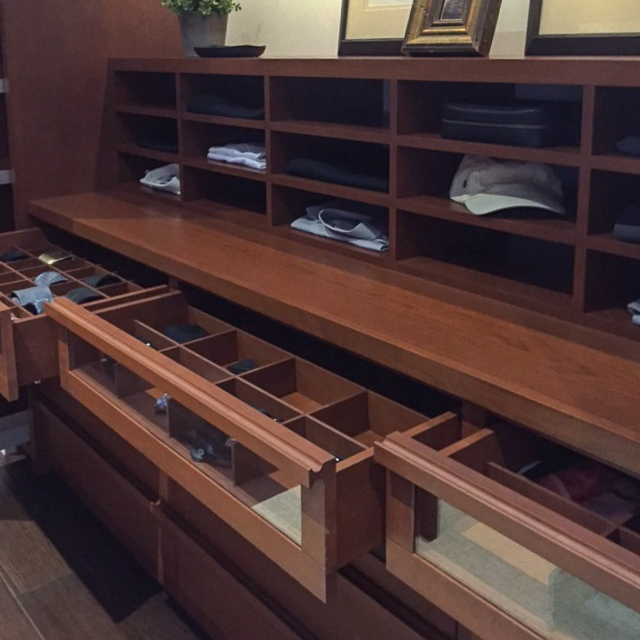It is a fact: We live in a multi-dimensional, multi-faceted, multi-tasking world. Life is a balancing act, and remaining organized is critical. Ironically, it is the seemingly minor everyday tasks that can pose the greatest challenges. How often have you wasted time rummaging around in your closet, trying to find your clothes or shoes for the day?
Far too many of us settle for closets that leave us rattled and rushing to start our busy day – but there is a better way! With thoughtful design and the right kind of décor items like built-in wall units, shelves and cabinets, a skillful designer can transform your closet from a jumbled state of confusion to a restful corner where order reigns supreme.
Closets by the Numbers
On a basic level, breaking down your closets according to purpose can help you kick off your closet project. In general, closet measurements and arrangements tend to fall into the following categories:
- Step-in closet – commonly used in a pantry, linen or entry way. Minimum of 3’ x 3’. Typically includes a shelf on a side or back wall.
- Reach-in closet – commonly used in bathrooms and bedrooms. Minimum of 24” deep. Typically includes a hanging rod, shelves and cabinets.
- Walk-in closets – commonly used in bathrooms and bedrooms. Designs come in an assortment of shapes and sizes, but minimum measurements are 4’ x 4’ with a 24” minimum clear passage aisle. Typically include hanging rods, built-in wall units, shelves and cabinets.
It is important to note that walk-in closets can range from a simple L-shape, set off with a couple of hanging sections and a few shelves – to an elaborate U-shape with many custom flourishes. It is the placement of elements throughout the space that takes priority, rather than the number of sections.
The Beauty of Shelves
Regardless of the type of closet, shelving provides a number of benefits over drawers and baskets, while serving the same purpose. And shelving does so at a lower price point, thereby freeing a bit of your budget for other parts of the project. Whether the closet in question is big or small, a shelving unit or two offers a wealth of possibilities.
Prior to choosing a system, make sure to take proper inventory and categorize your clothing to ensure you have a firm grasp on the most opportune way to display and store your items. This is important because many shelving units offer the flexibility for the user to select the baskets, bars and shelves they desire. And the smaller the closet, the greater potential shelving has to accommodate the majority or entirety of your wardrobe. A shelving unit provides additional support to the single bar that is found in many closets, giving users a place to stack folded clothes.
If your closet is on the cramped side, a floor-to-ceiling shelving unit is another option for opening up the space. By dedicating part of the design to built-in wall units, you give formerly loose items like shoes and purses their own place, leaving more room to sort hanging clothes in order. The result? A small closet that scores big on easy navigation.
Adding shelving to large closets is equally beneficial, for different reasons. A personal dressing room is on many ladies’ wish lists. You can fulfill this desire by installing a floor-to-ceiling shelving unit on a wall for clothes, then pairing it with a small bookcase for accessories, fragrances and makeup. Women with a shoe fetish can also use a bookcase or shelving unit to place shoes on display for easy selection and to make friends green with envy.
Remember, when planning your shelving design, envision organizing your items in a logical manner while maintaining the design aesthetic. Work with your consultant to create a presentation that appeals to the eye, yet serves a logical purpose to maximize the space in your closet.
In order to make the most of shelving units in closets, you must first determine their function and how they will coordinate with the overall design scheme. Once these decisions have been made, the fun part of finding the perfect shelves for your project begins.
Unexpected Elements with Impact
While they may not come to mind immediately, several other items can add cache and a personal touch to your closet’s aesthetic. Most work best in a walk-in closet, but they can be leveraged to expand other personal spaces, as well. For those of you who take a creative interest in styling your wardrobe, seating offers a respite spent lovingly perusing your clothing. To further elevate the feeling of luxuriating over the process, consider plush fabrics like velvet or leather for chairs, loveseats or footstools.
A rolling rack can become the busy professional’s best friend in terms of closet items. Think about the freedom to style your wardrobe for the week, before Monday hits with ferocity. Choose outfits for Monday through Friday, and assemble each outfit by linking the top and bottom hangers together. Then, top it off with jewelry and other accessories draped over the hanger. This will help you avoid indecisive or panic stricken moments as you are trying to race out of the door to work in the morning.
Believe it or not, a clever cabinet design can disguise a safe in the loveliest way imaginable. In particular, search for a safe with dividers and drawers, which enhances the decorative look. Store all high-end jewelry in the safe and give yourself piece of mind that these precious pieces are secure. This will allow you to use your classic closet jewelry system to store your less valuable, but still pretty, costume jewelry collection.
As you can see, the options for designing and arranging your closet in a way that facilitates a more productive, positive start to each day are virtually endless. Work closely with your consultant and flex your creative muscles to find the selections and design schemes that tickle your fancy.
Learn more about designing the closet of your dreams, marrying form and function, and easing your daily life.



